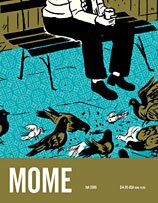Mome.
The Fall 2005 issue of Mome, from Fantagraphics, is an anthology of comics from several contributors. Printed on high quality paper with a fancy glossy sheen, Mome comes across like a Virginia Quarterly Review or Ploughshares – its serious presentation demands that the comic medium be considered with the same respect as any literary art form. On many levels, Mome succeeds admirably. It features a wide variety of artists with just as many separate styles and influences. Some take a traditional approach, like Jonathan Bennett’s “Needles and Pins,” and some dip into the experimental, like the minimalist “Event,” Anders Nilsen’s emotional tale told almost entirely by using different colored squares. While some of the comics in the anthology fall short of the high standards one would expect from a top literary journal, there are far more that are well-deserving of serious literary appreciation.
Sophie Crumb, who by now must be utterly sick of the inevitable comparisons to her famous father and, by extension, to underground commix in general, is about to get it again from me, so close your eyes: "Parker, the Vegan Bike Punk," looks like an R. Crumb drawn, G-rated version of Gilbert Sheldon’s "Little Orphan Amphetamine," and the message is the same - it's darned hard to hide that middle class bourgeois core. For example, I'll admit how easily Crumb the Younger exposed my own bourgeois core – I prefer her gently humorous "Parker" over the violent and depressing "Amphetamine." Crumb’s story makes the exact same point, but without the sledgehammer.
Jeffrey Brown’s "Our Jam Band Is Going to Be Sweet" is a tale as well-told as any story in The New Yorker. What seems at first to be a straightforward detective story along the "Law & Order" lines. Once the story begins to draw to its close, you realize that it wasn't about policework at all, but rather a revelation of apathy and betrayal. The spine of the piece is the pathos of the human condition, and the detective story line is only what cloaks it.
Andrice Arp’s "Cormorant Feathers" is a visual adaptation of a Japanese creation myth, explaining the origin of Japan's ruling class and their descent from gods. The blue/black two-tone coloring is reminiscent of the Ignatz series, as is the moody, dreamy quality of the illustrated narrative as a whole. "Feathers" recreates the birth of the father of Jimmu, Japan's legendary first emperor, and by dusting off classical mythology and repackaging it for comic book readers, comes across in this series as one of the two most creative stories presented.
Although Mome clearly wants to prove that comics are a serious artform, this isn’t to say the creators take themselves too seriously. In an interview with Publisher’s Weekly, editor Eric Reynolds says, "There's something fitting in having an anthology of contemporary talent named after an archaic word meaning 'blockhead.'"
____________________
Fantagraphics 2
Gary Groth & Eric Reynolds, Eds.
Fantagraphics, 2005
Softcover
136 pp.
This review originally appeared at TARGET="_blank">J LHLS.
Tuesday, May 23, 2006
<< Home
